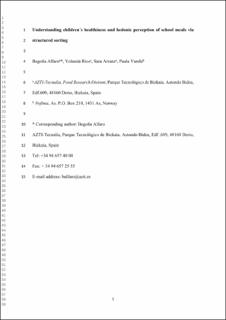Understanding children's healthiness and hedonic perception of school meals via structured sorting
| dc.contributor.author | Alfaro, Begoña | |
| dc.contributor.author | Ríos, Yolanda | |
| dc.contributor.author | Arranz, Sara | |
| dc.contributor.author | Varela-Tomasco, Paula Alejandra | |
| dc.date.accessioned | 2021-02-15T13:23:07Z | |
| dc.date.available | 2021-02-15T13:23:07Z | |
| dc.date.created | 2020-07-27T12:32:42Z | |
| dc.date.issued | 2020 | |
| dc.identifier.citation | Appetite. 2020, 144 . | en_US |
| dc.identifier.issn | 0195-6663 | |
| dc.identifier.uri | https://hdl.handle.net/11250/2728131 | |
| dc.description.abstract | Trends in the prevalence of childhood overweight and obesity in Europe and especially in Spain have continuously increased in the last three decades. The aim of this work was to study the healthiness understanding (healthy and unhealthy food) in children with different ages and to evaluate liking towards a set of school meals: first courses, second courses and fruit/dessert. Two hundred and seventy-seven children between the ages of six and twelve from three primary schools in northern Spain, Bizkaia, took part in this study. All the groups showed a good knowledge of the healthiness of the dishes offered in the school canteen. However, some dishes were difficult to assess for the 6-7- and 8-9-year old groups. Pasta and croquettes with chips were the most preferred dishes. Vegetables and fish dishes were the least preferred. Results suggest that children become increasingly aware of their preferences and critical in their choices with growing age. It was found in this study that there was a strongly inverse relationship between children's perceptions of the healthiness of foods and their preferences for them. The structured sorting task was a good tool for children to classify various dishes (complex food) considering healthiness and hedonic perception at the same time. In conclusion, these results contribute to a better understanding of children's nutritional perception (healthy/unhealthy food) and its relation to preferences of school meals, which is important for quality improvement and nutritional planning in school food services. | |
| dc.language.iso | eng | en_US |
| dc.subject | Sorting | |
| dc.subject | Sorting | |
| dc.subject | Barn | |
| dc.subject | Children | |
| dc.subject | Healthiness perception | |
| dc.subject | Healthiness perception | |
| dc.subject | Hedonic perception | |
| dc.subject | Hedonic perception | |
| dc.subject | School meals | |
| dc.subject | School meals | |
| dc.title | Understanding children's healthiness and hedonic perception of school meals via structured sorting | en_US |
| dc.type | Peer reviewed | en_US |
| dc.type | Journal article | en_US |
| dc.description.version | submittedVersion | |
| dc.source.pagenumber | 0 | en_US |
| dc.source.volume | 144 | en_US |
| dc.source.journal | Appetite | en_US |
| dc.identifier.doi | 10.1016/j.appet.2019.104466 | |
| dc.identifier.cristin | 1820601 | |
| dc.relation.project | Nofima AS: 201702 | |
| dc.relation.project | Norges forskningsråd: 262308 | |
| cristin.ispublished | true | |
| cristin.fulltext | preprint | |
| cristin.qualitycode | 1 |
Tilhørende fil(er)
Denne innførselen finnes i følgende samling(er)
-
Artikler / Articles [1456]
-
Publikasjoner fra CRIStin [2533]
